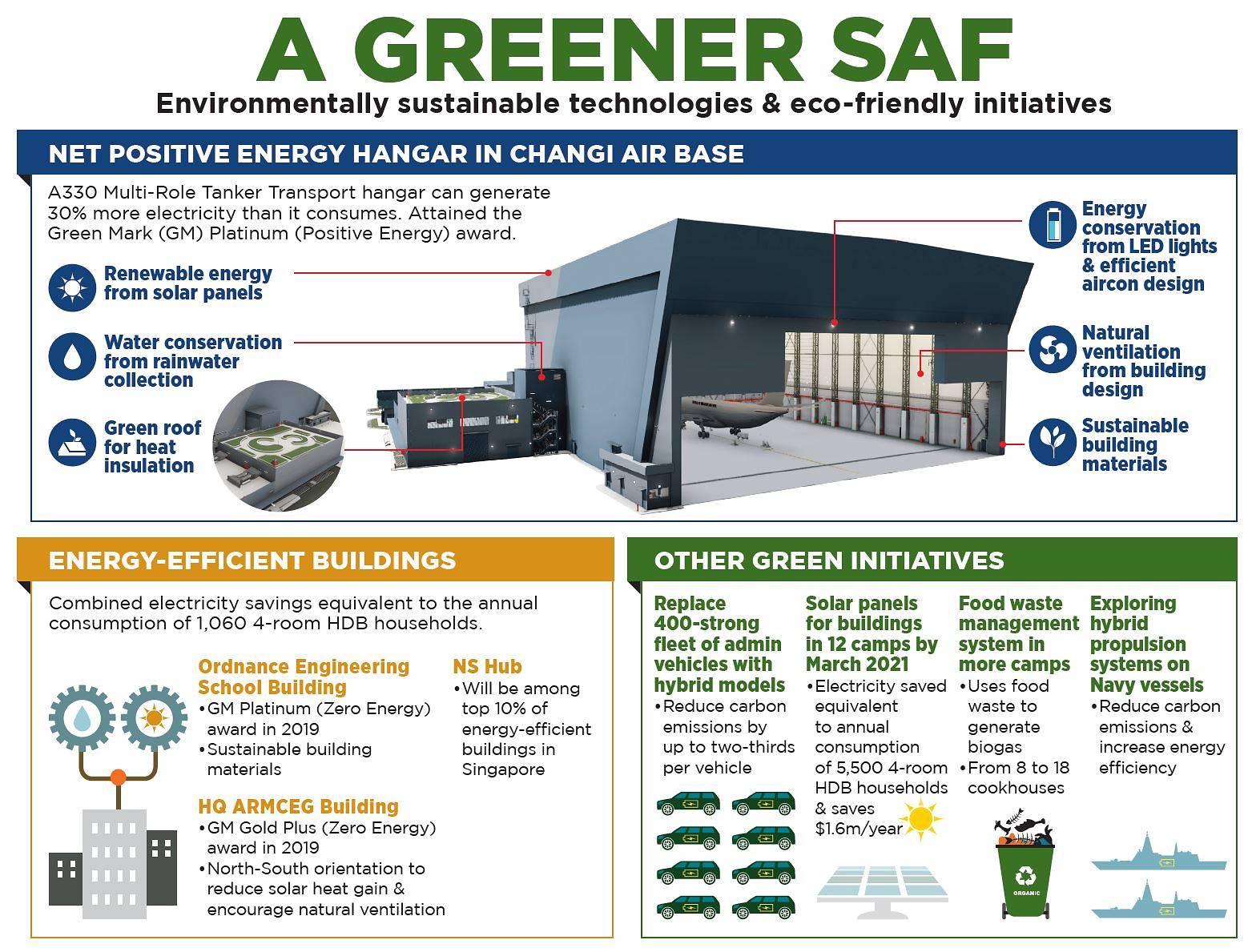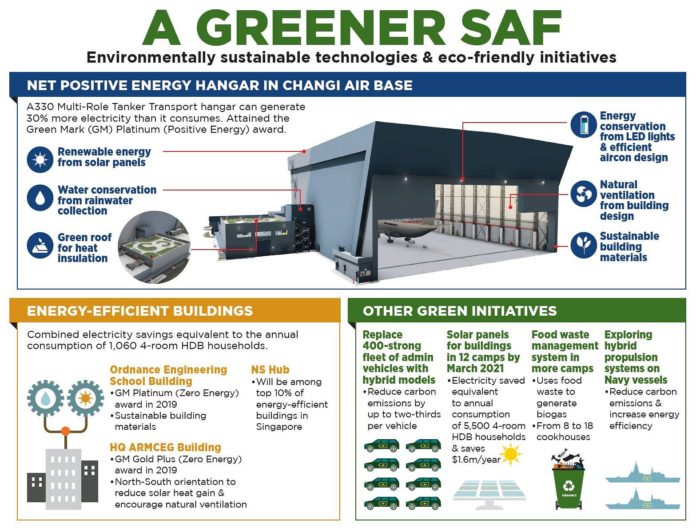SINGAPORE: The Singapore Armed Forces (SAF) is on a push to do its part for the environment, as it unveiled its first net energy positive building – a new eight-storey hangar that uses solar panels and natural ventilation features.
The hangar at Changi Air Base (East), built for the SAF’s multi-role tanker transport, can generate 1,225 megawatt-hours (MWh) of electricity a year, enough to power 273 four-room Housing Board flats. This is 30 per cent more than the energy it consumes, with the leftover used in other parts of the base.
Defence Minister Ng Eng Hen said in Parliament on Monday (Mar 2) that the SAF is doing its part in line with the national response to tackle climate change.
“Adapting to use green technologies could also reap operational advantages,” he said in his Committee of Supply debate speech, highlighting that the navy is exploring using energy-efficient hybrid propulsion systems that can increase warships’ endurance.
READ: SAF to restructure intelligence and cyber defence units, acquire new ships for maritime security amid evolving threats
The Ministry of Defence (MINDEF) said it is working with the Defence Science and Technology Agency to insert green features in new buildings during the design phase.
Some examples of energy-efficient buildings include the Ordnance Engineering School in Kranji Camp 3, which uses solar lighting and natural ventilation to generate its own electricity to fully meet demand.
The SAF will also install solar panels in 12 SAF camps to generate enough electricity to power 5,500 four-room flats.
“Besides making use of renewable energy and sustainable building materials, these facilities maximise water and energy conservation through water-efficient fittings as well as energy-efficient lighting and air-conditioning systems,” MINDEF said.
“When fully realised, these efforts combined will reduce 11,400 tonnes of carbon dioxide emissions by the end of March 2021.”
GREEN HANGAR
Leading the way is the multi-role tanker transport hangar, which is built facing the wind to optimise airflow. Large-span louvres also allow the air to escape for natural ventilation. This means the hangar does not need to have as many fans, reducing the energy it consumes.
The hangar also has a green roof with carpet grass that insulates the building against heat and doubles up as a recreation area. The moist soil under the grass acts as a layer against the heat, reducing the need for excessive air-conditioning in the rooms below.
Rainwater is also collected and recycled for general washing, flushing of toilets and irrigation of the green roof. Together with water-efficient fittings, MINDEF estimates that the building will each year save an amount of water equivalent to the consumption of 28 four-room flats.
The hangar comes with a panelled fabric door that allows some sunlight to pass through, reducing the need for excessive lighting. It also uses energy-efficient LED bulbs.
The head of the infrastructure and systems branch at the Republic of Singapore Air Force’s air plans department said the opportunity to make the hangar green came because of its sheer size. It has to be big enough to hold the tanker, which is the size of a commercial airplane.
“The large hangar offers the necessary space and area to incorporate these various technology,” Military Expert 6 Teo Keng Siang said, adding that this process of introducing green features at the design stage will “definitely” continue for future projects.
“For various projects, we see if it is cost-effective and sustainable. So whenever there is an opportunity, we will make it happen.”

The SAF is on a push to go green. (Graphic: MINDEF)
ELECTRIC VEHICLES ON THE CARDS
Still on green buildings, Dr Ng said MINDEF is working with its counterparts in Australia to incorporate environmentally sustainable design measures in its overseas training facility, such as solar-powered lighting and using building materials that have a higher proportion of recycled content.
READ: Army combat soldiers get new uniforms that cool, dry faster
The upcoming NS Hub, to be ready in 2023, also aims to be among the top 10 per cent of energy-efficient buildings in Singapore.
Beyond that, MINDEF said it will replace its 400 administrative vehicles with hybrid models by 2023, reducing carbon emissions by up to two-thirds per vehicle, and eventually with electric vehicles when Singapore’s charging infrastructure is built up.
To combat rising sea levels, MINDEF and the SAF are also working with relevant agencies closely on coastal adaptation, particularly on Singapore’s first polder development at Pulau Tekong.
“MINDEF and the SAF are on track to meet national targets to reduce energy and water consumption,” Dr Ng said.
“In the grand global scheme of changes necessary to mitigate climate change, our total reduction of carbon dioxide emissions might be considered insignificant, but all agencies and countries must start on this road to recovery.”





